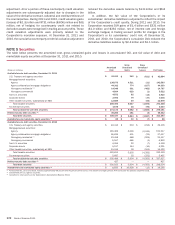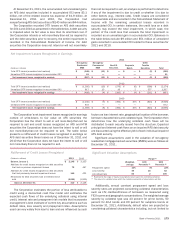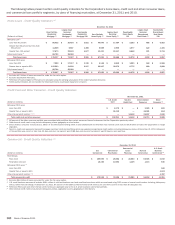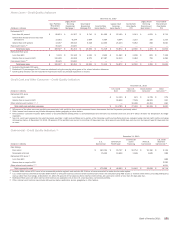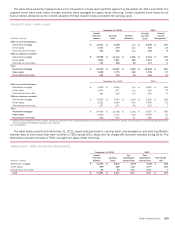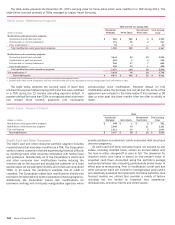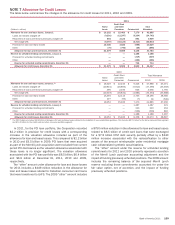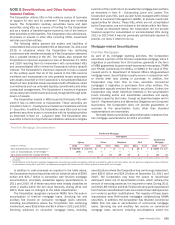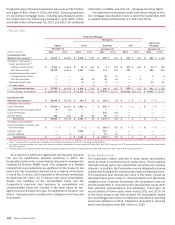Bank of America 2011 Annual Report Download - page 184
Download and view the complete annual report
Please find page 184 of the 2011 Bank of America annual report below. You can navigate through the pages in the report by either clicking on the pages listed below, or by using the keyword search tool below to find specific information within the annual report.182 Bank of America 2011
Impaired Loans and Troubled Debt Restructurings
A loan is considered impaired when, based on current information,
it is probable that the Corporation will be unable to collect all
amounts due from the borrower in accordance with the contractual
terms of the loan. Impaired loans include nonperforming
commercial loans, all TDRs, and the renegotiated credit card and
other consumer TDR portfolio (the renegotiated credit card and
other consumer TDR portfolio, collectively, the renegotiated TDR
portfolio). Impaired loans exclude nonperforming consumer loans
and nonperforming commercial leases unless they are classified
as TDRs. Loans accounted for under the fair value option are also
excluded. PCI loans are excluded and reported separately on page
188.
Home Loans
Impaired home loans within the home loans portfolio segment
consist entirely of TDRs. Excluding PCI loans, substantially all
modifications of home loans meet the definition of TDRs.
Modifications of home loans are done in accordance with the
government’s Making Home Affordable Program (modifications
under government programs) or the Corporation’s proprietary
programs (modifications under proprietary programs). These
modifications are considered to be TDRs if concessions have been
granted to borrowers experiencing financial difficulties.
Concessions may include reductions in interest rates,
capitalization of past due amounts, principal and/or interest
forbearance, payment extensions, principal and/or interest
forgiveness or combinations thereof.
Prior to permanently modifying a loan, the Corporation may
enter into trial modifications with certain borrowers under both
government and proprietary programs. Trial modifications generally
represent a three- to four-month period during which the borrower
makes monthly payments under the anticipated modified payment
terms. Upon successful completion of the trial period, the
Corporation and the borrower enter into a permanent modification.
In accordance with new accounting guidance effective in 2011, a
loan is classified as a TDR when a binding offer is extended to
borrowers to enter into a trial modification. At December 31, 2011,
the Corporation classified as TDRs $2.6 billion of home loans that
were participating in or had been offered a binding trial
modification. These home loans TDRs had an aggregate allowance
of $154 million at December 31, 2011. Approximately 55 percent
of all loans that entered into a trial modification during 2011
became permanent modifications as of December 31, 2011.
In accordance with applicable accounting guidance, home
loans are not classified as impaired loans unless they have been
designated as a TDR. Once such a loan has been designated as
a TDR, it is then individually assessed for impairment. Home loan
TDRs are measured primarily based on the net present value of
the estimated cash flows discounted at the loan’s original effective
interest rate. If the carrying value of a TDR exceeds this amount,
a specific allowance is recorded as a component of the allowance
for loan and lease losses. Alternatively, home loan TDRs that are
considered to be dependent solely on the collateral for repayment
(e.g., due to the lack of income verification) are measured based
on the estimated fair value of the collateral and a charge-off is
recorded if the carrying value exceeds the fair value of the
collateral. Home loans that reached 180 days past due prior to
modification would have been charged-off to their net realizable
value before they were modified as TDRs in accordance with
established policy. Therefore, the modification of home loans that
are 180 or more days past due as TDRs does not have an impact
on the allowance for credit losses nor are additional charge-offs
required at the time of modification. Subsequent declines in the
fair value of the collateral after a loan has reached 180 days past
due are recorded as charge-offs. Fully-insured loans are protected
against principal loss, and therefore, the Corporation does not
record an allowance for credit losses on the outstanding principal
balance, even after they have been modified in a TDR.
The net present value of the estimated cash flows is based on
model-driven estimates of projected payments, prepayments,
defaults and loss-given-default (LGD). Using statistical modeling
methodologies, the Corporation estimates the probability that a
loan will default prior to maturity based on the attributes of each
loan. The factors that are most relevant to the probability of default
are the refreshed LTV or in the case of a subordinated lien,
refreshed CLTV, borrower credit score, months since origination
(i.e., vintage) and geography. Each of these factors is further
broken down by present collection status (whether the loan is
current, delinquent, in default or in bankruptcy). Severity (or LGD)
is estimated based on the refreshed LTV for the first mortgages
or CLTV for subordinated liens. The estimates are based on the
Corporation’s historical experience, but are adjusted to reflect an
assessment of environmental factors that may not be reflected in
the historical data, such as changes in real estate values, local
and national economies, underwriting standards and the
regulatory environment. The probability of default models also
incorporate recent experience with modification programs, a loan’s
default history prior to modification and the change in borrower
payments post-modification.
At December 31, 2011 and 2010, remaining commitments to
lend additional funds to debtors whose terms have been modified
in a home loan TDR were immaterial. Home loan foreclosed
properties totaled $2.0 billion and $1.2 billion at December 31,
2011 and 2010.


